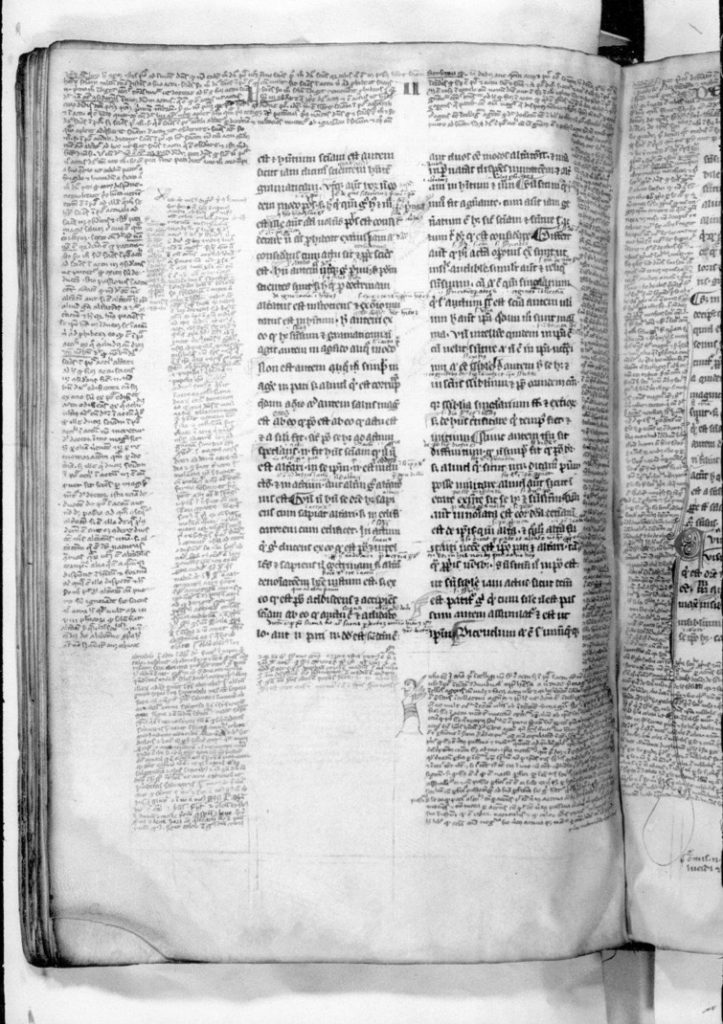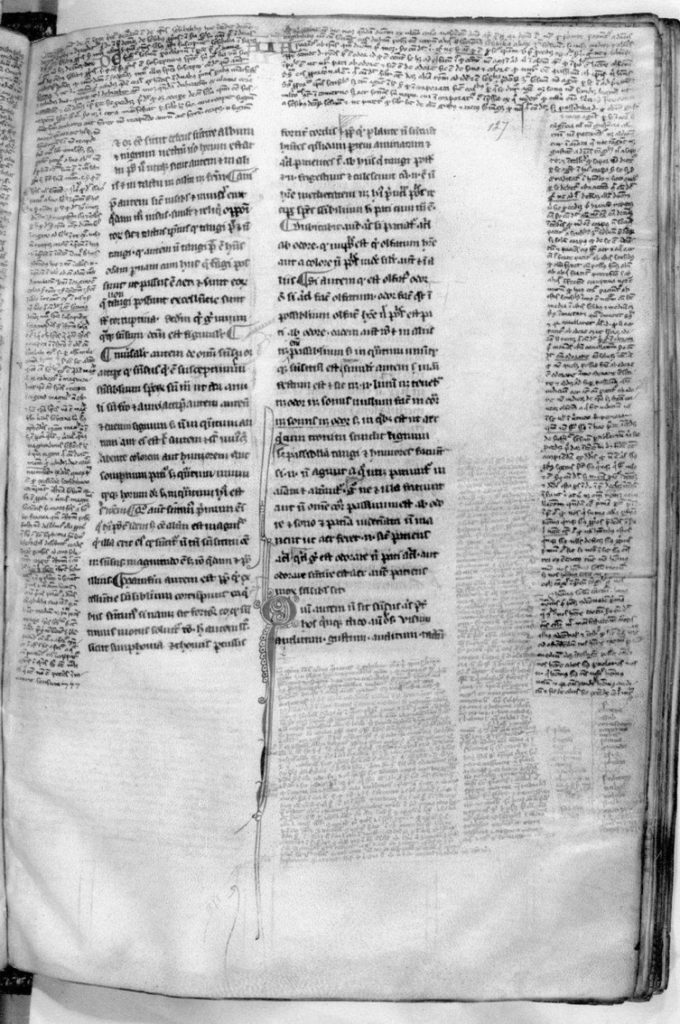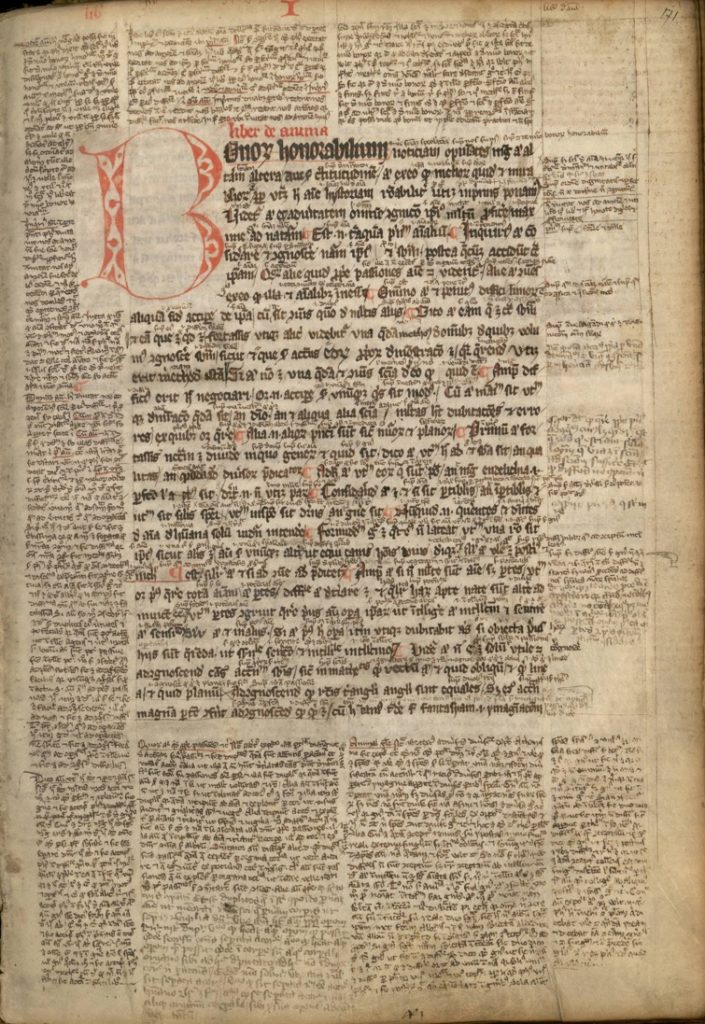More in general, the use masters of the arts faculty made of their manuscripts was one of my favourite subjects of research. For instance, manuscripts containing an Aristotelian treatise surrounded by glosses, clearly indicate that they were used in the classroom, or at least, that they were studied by a master who wanted to make Aristotle’s text more easily understandable. Some of these glossed manuscripts are still more exciting because they contain several layers of glosses, corresponding to different functions of the gloss. I once again chose the De anima, more familiar to me than the other treatises, to study this topic.
In this context I prepared a paper for a conference in Leiden, organized by Marieken Teewen, in 2017. As my paper was not published, I give the main part (with some corrections) here:
Masters of arts and Margins
For my research on methods and tools of teaching in the universities I concentrated on the natural sciences and particularly the Aristotelian treatise De anima and its commentaries.
In order to give a general idea of the way in which this kind of manuscripts can be found, here is a short description of the main tools. First, the Corpus Vetustius and the Corpus Recentius offer rich collections of Aristotle’s works. [The appellation Corpus Vetustius indicates a collection of Latin translations from Arabic or Greek, used in the schools before 1270; the Corpus Recentius contains manuscripts with the new translations from the Greek, meant to replace the translations from the Arabic, or new versions of the old translations from the Greek; the last prevails at the end of the 13th century.]
The codices of these two corpora have been described and studied since a long time (the basic work has been done by Lacombe from 1939 onwards), but of course much work remains to be done, especially from the codicological point of view, and also with regard to their use. The short descriptions in the volumes of the Aristoteles Latinus. Codices, mention the presence of glosses, but not systematically, especially regarding the question in which part of the often complex manuscripts one finds more or less extensive glosses.
The new catalogues of English manuscripts containing commentaries on Aristotelian works are very useful indeed. The first two volumes, concerning respectively Oxford and Cambridge, have been published by Rodney Thomson in 2011 and 2013. The third volume, concerning the libraries in London, is in progress. The descriptions here give more details (although they do not mention the composition of the quires, for instance, nor the dimensions of the page layout). For example, here is a passage from the Catalogue of Thomson on the Oxford manuscripts:
Bodleian Library, Canon. class. lat. 288; S. XIV in.; Paris
One learns that there are many glosses by different hands, but not where the glosses are ‘heavy’, nor if only one of the hands is responsible for them, and what may be the reason.
In this kind of codices marginal and interlinear glosses are frequent; sometimes a running commentary is also found in the lower margins or otherwise, like for instance the one of Adam of Buckfield on the Physics.
Let us take for example the MS Paris, BnF lat. 6319. This is a manuscript containing the Corpus Vetustius, dating from the thirteenth and the beginning of the fourteenth century (the basic Aristotelian text is from ca. 1250-1275; the glosses and commentaries mostly from the last third of the 13th century; dixit Patricia Stirnemann, a fine connoisseur of medieval manuscripts). It is a big codex (ca. 325×220 mm; I + 300 parchment sheets) and the text is written in two columns by various hands, with corrections and annotations. Its provenance is probably the south of France and/or Spain. The large margins are filled with glosses and commentaries, some anonymous, others attributed to Adam of Buckfield; a table of contents lists some of these commentaries.
The volume starts with the Physics, as these collections often do; here is the first page:
Paris, BnF lat. 6319 f. 3r
Another page of the same codex (123v) shows a part of the De anima, with heavy glossing and the commentary attributed to Adam of Buckfield. The outer margins are divided into two (sometimes three) columns, the exterior one is completely filled with glosses, the interior one less. However, this scheme may vary, as we see for instance on f. 127r (see the reproduction of both folios).
The whole treatise on the De anima has been glossed (so, commented upon) until the end (which is not the case of all the treatises in this volume). There is also an error in the order of the quires (which occurred during the (re)binding), so that the text begins on f. 113, while the actual f. 112 should have been inserted between 124 and 125 (which is also clear from the “réclame” – the first word of the next quire – in the lower margin).
Clearly, this kind of manuscript should be studied in detail, including the composition of the quires, the measures of the layout, the number of scribes, the various hands of the glosses, which texts have been glossed and which not, etc. For my conclusion on this manuscript (in French) after a close (but not final) inspection, see this website VI, 2.
BnF lat. 6319 f. 123v
BnF lat. 6319 f. 127r
Another example is the ms Sorbonne 567, a manuscript which comes from the library of the Collège Louis le Grand. It contains the Corpus Recentius and is somewhat different in aspect: the basic text has been written in one column, surrounded by glosses; the exterior margins are divided into two small columns, the inferior margins are also divided into two columns which fill the space just beneath the basic text. It is also a big volume (228 folios; 323×220 mm).
For the part containing the De anima (171r-178v, 181r-195v) there are marginal and interlinear glosses, but not always in the inferior margin, and sometimes there is almost nothing in the margins, for example 172v-176v; but at the beginning of book II there are many glosses and book III has been glossed until the end. This clearly indicates the interest aroused by the various parts of the text (usually, book III on the intellect is more heavily commented than the previous books). The description on the website of the Bibliothèque Interuniversaire de la Sorbonne just mentions the following:
MS 567, XIIIe siècle ; parchemin. 228 feuillets. 323 × 220 mm. Reliure en bois, recouvert de peau, avec fermoirs. Provenance : Collège Louis-le-Grand, 192. 1. 3.
Des éléments de décor du manuscrit ont été numérisés par l’IRHT. Ils sont consultables dans la Bibliothèque virtuelle des manuscrits médiévaux.
For a fuller description, see this website VI, 2. Here is an example, showing the beginning of the De anima:
Ms Sorbonne 567 f. 171v
Just as the manuscripts of the BnF mentioned above, this one also merits a close inspection and thorough description. And so there are many others.
Of course, the layout is not always the same. Sometimes the lower margin was reserved for a standard commentary (of Adam or Alfred of Sareshell for instance), while the inner and outer margins contain glosses. The margins were usually prepared for the glosses by the person responsible for the ruling of the pages: the ruling of the page includes the margins, divided into columns by vertical and horizontal lines. One can often see the pricks and the tracing of the lines themselves. This ruling was of course executed on demand of the master who ordered the making of the quires and the copying of the basic texts.
Sometimes also the pattern of subdivision of the margins is still more complicated: in some manuscripts the outer margins are divided into three columns and the inner ones into two narrow ones. An example of this is ms Paris, BnF lat. 12953, a rather early manuscript containing the Corpus Vetustius, accompanied by what has been called the ‘Glosa anglicana’ and in some places, glosses of Adam of Buckfield and Alfred of Sareshel. The manuscript has been digitized; here is a short material description of the layout:
Parchemin, 383 ff., ca. 335/340 × ca. 225/230 mm ; troisième quart du XIIIe siècle (vers 1250-1260) ; longues lignes, sauf 271v-275r ; réclames ; marges préparées pour gloses.
Justification ca. 165/170 x 90 (sauf ff 271v-275r : 2 colonnes de 245×70) ; lignes tracées à la mine de plomb, piqures (généralement visibles dans les marges inférieures, parfois aussi dans les marges extérieures, par ex. f 166) ; marges divisées en colonnes, par exemple 13r, ca. ?+5+12+5+20+5 pour la marge intérieure (difficile à voir à cause de la reliure trop serrée), texte 88/90, puis 5+20+5+22+5+20+5+15, donc deux colonnes dans la marge intérieure, une large colonne avec le texte de base, quatre colonnes dans la marge extérieure ; ce schéma reste à peu près le même, mais souvent il n’y a pas de gloses ; ensuite un peu différent : après la troisième colonne dans la marge extérieure il y a encore un espace, qui est utilisé pour des notes, des ajouts aux gloses dans la colonnes à côté ou des dessins ; justification ff 275-278 différente (2 colonnes).
As the manuscript contains decorations (painted initials, etc.), it has been described by art historians. Most initials have been executed in Parisian workshops, so we may assume a Parisian origin. It is certainly a manuscript that should be studied in detail.
Among the manuscripts kept in the English libraries there are many similar ones. They have been called ‘textbooks’, because they provide the basic texts on which the masters lectured. I quote a passage of the report of a meeting at the Warburg Institute in London, in 2015:
Finally, Charles Burnett, John Marenbon (Trinity College, Cambridge) and Cecilia Trifogli talked about Rod Thomson’s ‘Catalogue of Manuscripts of Latin Commentaries on Aristotle in British Libraries’, of which the first volume, concerning the Oxford manuscripts, appeared in 2011, the second, concerning the Cambridge manuscripts, in 2013. John Marenbon, as Project Director of Auctores Britannici Medii Aevi, explained the history and present aims of the series. C. Trifogli focused on what Thomson calls the textbooks, that is, manuscripts with no other contents apart from the texts of Aristotle and commentaries on them. These are indeed the most important sources for tracing the reception of Aristotle’s thought. She pointed out some remarkable examples of (1) textbooks of glosses and (2) of textbooks of commentaries from the thirteenth and early fourteenth century. Among the first, she presented the collections of glosses on logical works in mss. Oxford, Bodl., Rawlison G. 49; Cambridge, Gonville and Caius, 199/105; 465/572; 466/573; 468/575; 494/263 and the miscellaneous collections in mss. Oxford, Corpus Christi College, 111; 114; Cambridge, Gonville and Caius, 506/384. Among the second, she presented the miscellaneous collections in mss. Oxford, Merton, 272; Oxford, New College, 285; Oxford, Oriel, 33; Cambridge, Gonville and Caius, 367/589; 509/386; Peterhouse, 157; 192.
Finally, the question arises why people used this complicated layout of the page. There are of course many theological and juridical manuscripts in which the basic text was surrounded by glosses. However, I am not aware of any such manuscripts in which the margins are divided into several columns (but his may be ignorance). This design seems to be typical for the philosophical manuscripts.
These manuscripts were of course the basic tool of the masters who lectured on Aristotle’s works. The first master probably copied glosses (of his own make or taken from some other copy) in the margins of his manuscript and sometimes a popular and useful commentary like the ones of Adam of Buckfield. If he added his own comments while reading, these may be interlinear glosses or short notes in the interior column of the large, exterior margin. After him, a second master who came into possession of this specific manuscript maybe added his own comments; and so on. Sometimes we find glosses in a much later hand, which shows that the manuscript has been used by generations of scholars.
In general, one can say that the columns in the margins are meant to contain two different levels of glosses: close to the basic text there are corrections or small explications, the larger outer columns and the inferior margins contain longer comments concerning the more difficult points or the deeper meaning of the text. However, the exact functioning of each manuscript and its different levels of glosses remains to be studied.
Some bibliographical information:
Aristoteles Latinus, Codices, descripsit Georgius Lacombe, Roma 1939-1955.
R. Thomson, Catalogue of Manuscripts of Latin Commentaries on Aristotle in British Libraries, I. Oxford, Turnhout 2011; II. Cambridge, Turnhout 2013.
Ch. Burnett, « The introduction of Aristotle’s natural philosophy in Great Britain: a preliminary survey of the manuscript evidence », Aristotle in Britain during the Middle Ages, 1996, p. 21-50; Ch. Burnett, A. Mendelsohn, « Aristotle and Averroes on Method in the Middle Ages and Renaissance: the ‘Oxford Gloss’ to the Physics and Pietro d’Afeltro’s Expositio Proemii Averroys », Method and Order in Renaissance Philosophy of Nature. The Aristotle Commentary Tradition, 1997, p. 53-111.
On illustrations: R. Branner , Manuscript Painting in Paris during the Reign of Saint Louis , Berkeley-Los Angeles, 1977, 8 (n. 35), 21 (n. 66), 104, 125, 229, 236-237 et fig. 288, 368, 372.
Alison STONES, Gothic manuscripts: c. 1260-1320, London: H. Miller ; Turnhout : Brepols, 2013.
On the ‘Glosa Anglicana’: Emmanuelle Kuhry, “An Early Witness of the ‘Glossa anglicana’ and of Adam of Buckfield’s Commentaries: the Compilatio de libris naturalibus Aristotelis (Compendium philosophie)”, in Revue de théologie et de philosophie (in press).
Other glossed manuscripts
Apart from the manuscripts mentioned above, I also studied some other copies of the De anima accompanied by glosses, for instance Paris, BnF 6302, 6319, 6323, 6325, etc. Because I plan to work on this subject in the next years, the descriptions, in the unfinished form they have for the moment, may be found under Part VI.
Other glossed manuscripts were called to my attention in the context of the research project of Dragos Calma on the Liber de causis, a pseudo-Aristotelian text that was often copied with other Aristotelian works. During a conference organized in Paris in 2017, I gave a paper on the glossed copies of the Liber de causis in Parisian manuscripts. The paper has been published in the volume of proceedings: The Elements of Theology and the Book on causes from the 5th to the 16th centuries, I (see List of publications, art. 73). The examination of the codices, mostly assembling a more or less large number of Aristotelian works, showed that in comparison to the other texts the De causis had not been much glossed; this indicates that the treatise did not attract the interest of the masters of the arts faculty in the same manner as for instance the Physics or the De anima. Here is my conclusion:
Si l’on peut tirer des conclusions sur la base des seuls manuscrits parisiens, on pourrait dire que le Liber de causis, bien que connu et lu par les théologiens, comme le montre Irene Caiazzo dans ce même volume, ne suscitait pas l’enthousiasme chez les maîtres ès arts. Il y a bien quelques gloses de la main de ceux qui étudiaient et enseignaient les oeuvres d’Aristote, mais elles sont très limitées par rapport aux gloses accompagnant d’autres œuvres, comme la
Physique, la Métaphysique, le De anima et les Parva naturalia. Bien entendu, de multiples questions se posent à propos de la documentation présentée ici, par exemple de quelle époque datent les gloses dans les divers manuscrits, sont-elles dues à un ou plusieurs annotateurs dans chacun de ces manuscrits, ces gloses se répètent-elles? Pour y répondre il sera nécessaire de faire le long et laborieux travail du déchiffrement de toutes les gloses, travail dont le résultat pourrait d’ailleurs être assez décevant. Espérons que quelqu’un aura le courage de s’y attaquer.





Commentaires récents